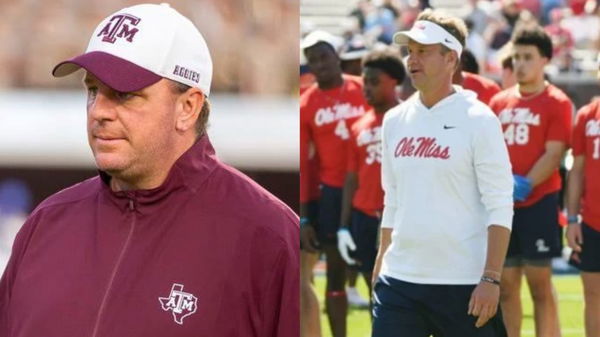

There are going to be big changes in the SEC as the conference braces itself for the pandemonium that the NCAA’s new rule might be bringing. There have been talks about limiting the roster size to 85 players after the NCAA’s settlement agreement. While there is no final decision on this rule yet, it’s not sitting well with many people.
One of the HCs who took a strong stand against this rule to eliminate walk-ons is Texas A&M Aggies HC Mike Elko who argued that this rule is “something that’s really bad for the sport.” He openly displayed his disapproval saying, “I’m strongly against it. I think it’s absolutely against college football, what it stands for and what it’s about.” And he isn’t the only one who thinks this is an absurd rule.
Lane Kiffin backs Mike Elko in protesting against the NCAA’s ideal roster size
ADVERTISEMENT
Article continues below this ad
SEC head coaches do not seem pleased with the NCAA’s newly proposed rule about minimizing their team’s roster size to 85 players. Following the Texas HC’s statement, Ole Miss HC Lane Kiffin took to his IG story to post a picture of Mike Elko with the statement, “I’m strongly against it.” In his story, he showed his own disapproval and wrote, “Horrible idea!!!!!”
ADVERTISEMENT
Article continues below this ad

via Imago
Image Credits : Imago
This came after the NCAA and the Power Five conferences locked a settlement agreement that allows schools to directly pay their student-athletes. The idea behind this is that a sort of cap is necessary for an even balance between schools as there are only 85 full scholarships. After all, it’s going to depend on the programs and how they’re going to distribute the money that’ll come from the NCAA settlement agreement.
NCAA and Power 5 settlement agreement
ADVERTISEMENT
Article continues below this ad
On Thursday, the NCAA and the Power 5 conferences came together to agree to a settlement deal where “athletes can be paid directly by schools.” Under this agreement, the NCAA will “pay past and current athletes $2.7B over 10 years.” This deal applies to both current and “all Division I Athletes dating back to 2016.”
That being the first part of the deal, the second part is that each school will also receive $20 million. The way the schools choose to distribute the revenue among the players is dependent on the particular program. While this is a lucrative move for student-athletes who are eligible to receive payment, there has also been some scrutiny over non-eligible players. Is the trimming of the roster size necessary to fit this NCAA rule? Let us know your comments.
ADVERTISEMENT
ADVERTISEMENT
ADVERTISEMENT


